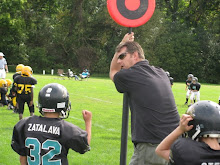Connectivism: My Mind Map
The underlying theme of connectivism as a learning theory is how we as learners “connect” with our learning and how we make “connections” in order to learn. At least this is my interpretation of the general definition of the theory, which actually states according to George Siemens “ connectivism integrates technology, social networking, and information” (Siemens, 2009). In fact, expanding on this definition Siemens also defines “connectivism as the combined effect of chaos theory, importance of networks, and the interplay of complexity and self-organization” (Davis, C., Edmunds, E., & Kelly-Batemen, V., 2008). The idea of this mind map exercise is the literal illustration of the last component--self-organization.
To make a connection between the theory of connectivism and adult learning, I would also add that for a mind map to even exist, we as adult learners must have self directed learning and be intrinsically motivated. In fact, “self-directed learning is defined as the process in which individuals take on the responsibility for their own learning process by diagnosing their personal learning needs, setting goals, identifying resources, implementing strategies and evaluating outcomes” (Conlan, J., Grabowski, S., & Smith, K., 2003). Mind mapping can easily fit into the components of this definition by providing the “map” of our own needs, resources, and strategies to our self directed learning.
Connectivism by George Siemens’ definition is complex due to an abundance of information and the primary use of technology as the method to acquire knowledge and to learn (Siemens, 2009). However, I believe this complexity is an evolving process that I am aspiring to, as evident in the simplicity of my own mind map seen here on this page (Posted December 2,2009). I am usually a person who likes to keep things simple by my own design, in order to limit my own potential confusion in acquiring knowledge. This might be attributed to my self-declared dominant learning style, which I consider myself to be a very kinesthetic learner. In fact, I learn best by doing and manipulating the environment to my own discretion to meet my needs at any given moment. For example, I recently had to fix my dishwasher and to do so I had to first diagnose the problem and find the correct part, so I “Googled” it. In doing so, I was able to learn enough from technical drawings and other resource sites about the above-mentioned process to feel confident enough to fix it myself. Long story short I fixed my dishwasher (for a third of the cost of a repairman) going through everything I have mentioned in this posting, utilizing adult learning theory and connectivism to accomplish my goal of fixing the dishwasher.
References:
Conlan, J., Grabowski, S., & Smith, K. (2003). Adult learning. In M. Orey (Ed.), Emerging perspectives on learning, teaching, and technology. Retrieved on November 30, 2009, from http://projects.coe.uga.edu/epltt/index.php?title=Adult_Learning.
Davis, C., Edmunds, E., & Kelly-Bateman, V. (2008). Connectivism. In M. Orey (Ed.), Emerging perspectives on learning, teaching, and technology. Retrieved on November 30, 2009, from http://projects.coe.uga.edu/epltt/index.php?title=Connectivism
Siemens, George. (2009) “Connectivism”. Laureate Education, Inc. Retrieved Dec 2, 2009. [Transcript}
Making the Case for Employee Development
14 years ago




No comments:
Post a Comment